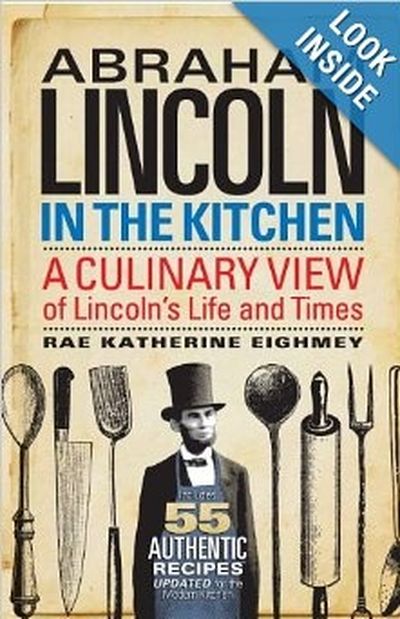Lincoln cookbook combines food and a touch of history

Quick Look: The 16th president of the United States didn’t say much about food in his writings. But, through old cookbooks, period papers and family documents, Rae Katherine Eighmey peers back in time and into his kitchen, adapting 55 vintage recipes for the modern cook in “Abraham Lincoln in the Kitchen: A Culinary View of Lincoln’s Life and Times,” published this month – just in time for his birthday (Abraham Lincoln was born Feb. 12, 1809).
What’s Inside: Part biography, part cookbook and part food memoir, this manuscript brings to life the cuisine of the well-to-do from 1820 through 1865. The author shares anecdotes about tracking down and attempting original recipes as well as updating them for today’s kitchens as though she’s discussing them with an old friend. Recipes are tucked at the end of each of the 14 chapters, after descriptions, vignettes and musings.
Eighmey discusses Lincoln’s White House as well as his early years, growing up on a farm near the southwest tip of Indiana, and his courtship with Mary Todd Lincoln, including her almond “courting cake,” which the president reportedly called “the best cake I ever ate.” Eighmey also examines the Lincolns’ garbage. Excavations at the family’s Springfield, Ill., home revealed evidence of what they ate: eggs, peaches, beef sirloin, lamb, chicken and turkey, like the 8-pounder which, on Jan. 10, 1859, cost Mary Todd Lincoln 80 cents. Pigs’ feet, often used for extracting gelatin for making fancy molded desserts or pigs-feet jelly or soup, made up nearly half of the pork remnants.
In the acknowledgements, Eighmey writes that the culinary time travel started with a simple question: “What do you think Abraham Lincoln enjoyed eating?” She walks curious cooks through her exploration, offering a seat at the president’s table along with a taste of American history: corn cakes, gingerbread, gooseberry pudding, pumpkin butter, barbecue chicken, biscuits, beef cakes, piccalilli, cucumber catsup, cranberry pie and shortbread cookies – just to name a few.
What’s Not: There are no photographs.
French Almond Cake
The original 1828 recipe calls for both sweet and bitter almonds, which are poisonous and no longer sold. However, pure almond extract is made from these nuts.
Nearly 200 years ago, making this “courting cake” was a two-day process. Almonds needed to be blanched, peeled and pounded into a powder the day before baking. This adaptation can be ready in an hour or so – just in time for Valentine’s Day.
“It may well be that the delicate texture and light almond flavor with a hint of lemon loosened Lincoln’s tongue enough for him to speak of his deep feelings,” Eighmey writes.
To update the recipe but remain as authentic as possible, Eighmey doesn’t include baking soda, an ingredient that wasn’t commonly called for in cookbooks until the 1870s, some 30 years after Mary Todd and Lincoln’s engagement.
4 large eggs, separated
1/2 cup granulated sugar, pulverized
3/4 teaspoon pure almond extract
1/4 teaspoon pure lemon extract
3 ounces blanched slivered almond, finely crushed or chopped into 1/16-inch pieces
1/4 cup unbleached all-purpose flour, sifted 3 times
Preheat oven to 350 degrees. In a deep, large bowl, beat egg whites until they stand in stiff peaks, then set aside. In a second large bowl, using an electric mixer, beat egg yolks until they are thick and have turned into a light yellow color. This could take as long as 5 minutes. With the mixer running, begin adding the sugar about a tablespoon at a time. Continue beating until the sugar is fully incorporated and the batter is thick. Stir in the almond and lemon extracts and then the almonds. Stir in the flour. With a flexible rubber spatula, fold about one-third of the beaten egg whites into the egg yolk batter to lighten it up. Then gently fold this lightened batter into the remaining egg whites. Pour the batter into an ungreased tube pan. Bake until the cake is firm and lightly browned on top, about 25 to 30 minutes. Invert the pan over a bottle to cool completely before removing the cake from the pan.